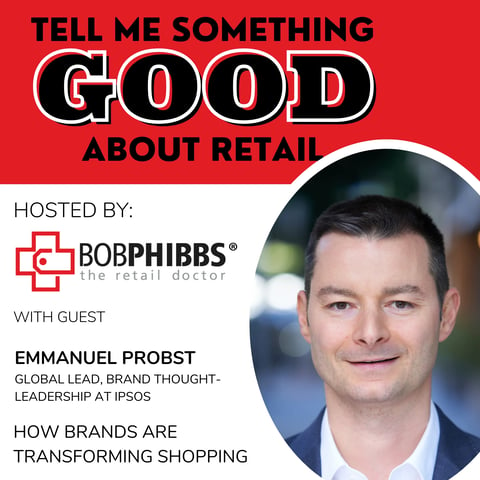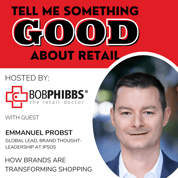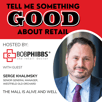Retail Podcast 802: Emmanuel Probst How Brands Are Transforming Shopping

Bob Phibbs interviewed Dr. Emmanuel Probst, Global Lead, Brand Thought-Leadership at Ipsos and best-selling author, about brand strategy - and more - on this episode of Tell Me Something Good About Retail.

Tell me something good about retail
Emmanuel Probst How Brands Are Transforming Shopping
We need products that make an impact on us and the world we live in. But how to understand a roadmap for changing your brand? Tiffany’s has done a great job of moving out of the “Breakfast at Tiffany's” lore of Audrey Hepburn, which fewer customers even know about. Brand strategy and advertising have changed whereby marketing professionals, brand strategists, can no longer dictate the brand to the audience but must be willing to co-create with the audience, or else the brand might get canceled. We’ll discuss all of this and more in this episode.
Bob: Today I'm talking with Emmanuel Probst. He's the author of the new book, "Assemblage: The Art and Science of Brand Transformation." The book features in-depth research in consumer psychology, consumer insights, interviews with industry-leading marketers, and case studies of transformative brands, big and small. Welcome, my friend.
Emmanuel: Bob, thank you so much for having me on the show. It's great reconnecting with you.
Bob: I know. It's been a couple of years, my friend, when we were talking about your last book. So, what was the impetus for you to write "Assemblage?"
Emmanuel: Yeah, "Assemblage" starts from we are overwhelmed with products and brands. "Assemblage" is about to show you a better way, a more meaningful way to build brands and products. And it's to say, as consumers, we don't need any more products, if you will. We need products that make an impact on us and the world we live in. So, that's the starting point for the book, is to say, as marketers, as brand strategists, as retailers, we have an opportunity not just to sell merchandise. Importantly, we have an opportunity to make a positive impact on people and the world around them.
Bob: Well, if my Facebook feed is any example, I have more products in my feeds than, I think, friends these days, right? Everybody seems to have an idea or a brand. And what brands are doing this well, do you think?
Emmanuel: That's a great question. I think different brands can do well on different levels. Are they going to transform people, are they going to transform their local communities or are they going to transform the world they live in? So, a brand that comes to mind is Airbnb.
Airbnb does well because Airbnb does not just provide you with a bed and pillow, but Airbnb provides you with an opportunity to discover and to engage with the local community. And Airbnb, as such, fulfills your need for adventure and discovery. So, you have a functional aspect of your stay, and that's a bed and a pillow, and a clean bathroom. And that is a functional aspect you will receive from Marriott and Hilton. They do that well too.
You also have an emotional dimension and something that's fulfilling, that is to connect with the local community, to discover a new neighborhood, to have the host show you around, for example, to take part in local experiences. And now that's enhanced experience, if you will, whereby the brand takes you from who you are to who you want to become. And in that regard, Airbnb participates in your personal transformation.
Bob: That's interesting. But I've never used Airbnb. I'm a Marriott guy, sorry. And do you think that's a generational difference though? Because I'm 64 and I think an awful lot of my generation was work your butt off and you get to go travel when you're done. That was what we grew up with. And it's the exact opposite pretty much, I think, for younger people, millennials, gen Z, is see the world now while you can, the world's your oyster, so every experience is great. So, do you think there are generational differences when you're talking about consumer psychology and branding?
Emmanuel: I'm certain. To your point, we've seen in our studies that younger consumers, first off are willing to talk back at brands, are willing to engage in an interaction, and in that regard the world of brand strategy and advertising has changed whereby marketing professionals and brand strategists can no longer dictate the brand to the audience, but must be willing to co-create with the audience, or else the brand might get cancelled.
And, second point, we see with GenZ, with millennials, with younger consumers, they expect the brand to make an impact. They expect the brand to not just talk about, but to demonstrate sustainability. They might expect the brand to take a stance on some societal and even on some political issues. And that is very clear, again, from our studies.
We see this divide literally between let's say older consumers and younger generations, this ability they have to talk back and interact and think about the ability to amplify whereby 10, 15, 20 years ago, we would say, well, when you say something good about a brand, you're going to tell three people about it, when you say something bad about a brand, you will tell seven people about it. And now when you say something good about a brand, you will tell 3,000 people about it and if you have something bad to say, you might reach 70,000 people.
Bob: But it also opens the thought around greenwashing or pride washing, or pinkwashing a brand and saying, "Look at all we're doing." And you're like, "Dude, your logo's in a rainbow, so therefore, you support gay rights." Or "we did a Black Lives Matter post back then." And I think a lot of consumers see through it. So, what makes it authentic?
I mean, I think if we were talking about an authentic retail brand, I think Patagonia is certainly the one that comes to mind. Its mission is clear. I've never run into a retailer with a sign out front that says, "Don't buy what you don't need." That's the inverse opposite of what I try to do with my clients. So, I think they totally get it. But what retailers do you think need to do better if what you say is either a real third rail for them, right, if you do this wrong, they're never going to come back, if you do it right, it's going to propel you?
Emmanuel: One, I don't think brand purpose is for everyone. You spoke about greenwashing. That is very true. Let's face it, some brands can be on board with sustainability and some brands cannot. And I don't like picking on brands because I want to be respectful of these people's endeavors.
But I was traveling through London recently and at London Heathrow, which is one of the 10 largest airports in the world, you have billboards everywhere saying, "Oh, London Heathrow will be carbon neutral by 2030." And that's just ironic, to put it in the nicest possible way. How can an airport be carbon neutral? And so, if you read the small prints, well really it's not the airport, it's the airport operation. Oh, and by the way, it's not the entire operation, it's just some parts of some buildings.
So, to your point, Bob, people see through this, and that is not genuine and authentic. And to address your question on what retailers should do and brands should do is indeed not only talk about your purpose, importantly to demonstrate your purpose. And that is why Patagonia is so strong because they literally put their money where their mouth is and demonstrate their purpose.
And with that said, I think that it's an anecdotal example. It's a great inspiration for our industry and for mankind, maybe. However, it's anecdotal just because, Bob, you challenge me on this, but if you and I go to our clients on Monday morning and start telling people, "Hey, give your entire company to either a charity or global organization or something like this. Oh, and by the way, pay the taxes," I mean, I don't know about you, but I don't think any of my clients are going to get on board with that. So, it's inspirational yet anecdotal.
Bob: It's funny, I have my cereal box this morning. I think it's Kashi, and it said at the bottom, 1%, big, three inches across the bottom, "Notice we give 1% back to sustainable something." And I just shook my head like, "Really?" I mean, 1%, is that a look at what we're doing? It's 1%. Does anyone even know 1%? At that point, you're like, "That's a reach."
So, how does a brand transform from we're carbon neutral in 2030 and we're an airport? Well, not really. Well, not really. Well, not really. Well, actually just a couple things. How do we get out of the marketing speak and transform that where it does feel authentic? So many brands, I think, have so many levels and silos that it's hard to... I mean, it certainly starts at the top, I think, right? The CEO has got to sign on and say, "This is important, and here's what we're going to do." But what do you think? How does a brand transform, Emmanuel?
Emmanuel: Well, I think the brand also needs to stay close to its original product and its original function, not just purpose. Let me explain. A brand that does well is Dove, for example. It's a brand by Unilever. It does well because for, what, about seven years now, it has been promoting the real beauty project.
And that's coherent, meaning Dove is a personal care product to wash your body, your skin, your hair, and that's fine. And it's on a mission to enable people to be beautiful no matter their body shapes and their age, and their skin tone, and maybe some skin conditions, and so on and so forth. So, that's coherent. That's coherent between the product, between the brand. And the mission makes sense because it's an important debate in society and it is coherent for a brand to lead that debate.
Bob: Well, but to your point, that was seven years ago. Go back nine years, they're pretty much white women with blonde hair.
Emmanuel: Exactly. And that starts to develop.
Bob: I could be wrong, we might have had different ethnicities, but it certainly wasn't someone who was out of a Madison Avenue typical mold. Something had to change where someone said, "We want to see people with their warts. We don't want to see airbrushed and all of those things," right? Isn't that what drove it?
Emmanuel: It's exactly it. And this movement has evolved and gained traction to the point that some agencies like Ogilvy in the UK, for example, no longer Photoshop models. So, they have a commitment to authenticity. That's back to your question, how can we be authentic? Well, by showing candid pictures of how people really look like.
And it's interesting you used this expression, Madison Avenue, because I read this week that although we've been using this expression Madison Avenue in the industry for a long time, it really refers to the '70s and to that "Mad Men" era if you will. It turns out that the very last ad agency that was on Madison Avenue just moved out. It was TBWA in New York. And TBWA in New York relocated to new offices, I think, on the west side.
Anyway, in any case, there is no agency, ad agency left on Madison Avenue. And I'm saying this because I think it's interesting as a metaphor, if you will, you and I don't care if those agencies are really on Madison Avenue or two blocks south, or should I say east or west? But what's important is this metaphor of Madison Avenue maybe moving forward will refer to that bygone era was Ogilvy, David Ogilvy type of advertisers and Don Draper basically from the '70s.
Bob: Well, there was one way to do it, right? Everybody had that one way.
Emmanuel: Exactly.
Bob: They're really selling ads and that's really not the case. You can have the most creative things in the world, but they were all together because the customer would come to them, right? Everybody bowed down to whatever Madison Avenue told them to be. Take our brand, and make it look like everyone pretty much fits in, right?
Emmanuel: Oh, very true. But that's another important metaphor to show that the industry doesn't dictate neither to the audience nor to advertisers what they should do and how they should think. I think that's an important change. It's a co-creation process. And that goes back, Bob, to what you were saying about different generations. We see this time and again in our studies at Ipsos. If you're 18 to 35, you don't want people to tell you what to do. You want to co-create with the brand, with the institution. You want to have a voice.
Bob: I think the one thing that we think about, certainly when I was growing up, we had three TV channels, right? And they were pretty much all black and white. And it was an idea of how do you get people to want to look like those people in the ads? But that's still true, isn't it? I mean, now we have influencers. So, we want them to go to Instagram or we want them to do something that catches our interest and it's much more fragmented as well. So, if you were thinking of an example of a case study let's say in your new book, "Assemblage" of somebody that did transform, what kind of things did they have to do to earn a place in your book, my friend?
Emmanuel: Well, in the book we talk about important archetypes, about anti-heroes, villains, and saviors. So, you mentioned influencers versus maybe celebrities in advertising 20, 30, 40 years ago. What influencers have going on for them theoretically is they're relatable, they're authentic. That's because they reduce what we call the social distance between you and the personality. And what I mean by this is George Clooney for example, well, they might be celebrities, but they're not necessarily relatable because you and I don't live that...I mean, maybe you do, Bob, but I do not.
Bob: I totally do. I'm on my yacht right now in the south of France.
Emmanuel: Exactly.
Bob: No, I'm kidding.
Emmanuel: You got it. An influencer...
Bob: It's funny you say that because a lot of brands still market luxury brands. George Clooney's wearing this. You want to be George Clooney because he's hot and all the girls want him. But this generational thing, I think, so many people miss. That's exactly why you would trust an influencer and not George Clooney. Is that what you're saying?
Emmanuel: I'm saying George Clooney is aspirational for a specific market segment and he's very high up, so to a luxury brand, it might make sense. But I'm saying that think about Tiffany's. Tiffany's is a good example whereby they recently advertised with, if I may use this expression, girls next door, right?
Bob: Yeah. Huge success with that, right?
Emmanuel: Exactly.
Bob: Huge.
Emmanuel: Exactly. Because now the company is relatable, it feels genuine, it feels authentic, it feels close to you, and that is going to drive traffic for the brand. And from a retail standpoint, I'm sure, Bob, and I'm interested to hear your take on this, for me, luxury retail in diamonds and watches and all that, frankly, it's very cliche. And of course, they need a lot of security, right?
But what I mean by very cliche is you have the sales clerk with the key around the wrist, and you know the type, and let me go to a safe. And you have kind of that almost confrontational interaction because the sales assistant is on the one side of the table and you're on the other. And all this is very stuffy. That's what I mean. All this is very stuffy. And I think that Tiffany is taking that creative risk, which I fully endorse, if you will.
Tiffany said, "We can no longer just sell silverware and gifts to grandmas." That's literally what they said. We need to be new. This Audrey Hepburn thing is a symbol that the younger people don't even know of and frankly don't care for. So, taking this creative risk of making the brand more authentic and more relatable, that's my answer to your question really, is to collaborate with people and orchestrate campaigns that feel closer to the audience.
Bob: Excellent. Well, after a little break here, you and I are going to talk about Macy's. You had a question before we got on the podcast today. So, we'll talk about that and more.
And we'll return now with Emmanuel Probst, author of "Assemblage: The Art and Science of Brand Transformation." So, Emmanuel, you had a question for me, something about Macy's. Would you restate that, please?
Emmanuel: I sure will. And I'm calling on your expertise in the retail field and here's what I see around me. I see small stores, high-end, that deliver a great experience. I'm thinking of Kiehl's, I'm thinking of Malin+Goetz, I'm thinking of Allen Edmonds, for example. I think those brands do a great job at delivering a really personal service. They charge a premium and that's fine, but justified.
And on the other end, I see Amazon with virtually unlimited inventory. And my question to you is, Macy's, for example, stores at, what, 120 to 220,000 square feet. And my experience as a shopper is that store is too small to compete with Amazon on inventory and price. However, it's too big to deliver a truly personal experience.
So, please forgive my... And I don't mean to be cynical because I want them to do well, and I want them to succeed and I want their employees to keep their jobs. But how do they manage to find success stuck between a personal, luxurious, authentic retail experience on one hand and an unlimited store that is Amazon on the other?
Bob: Well, I don't buy the Amazon thing, my friend, first because Amazon, as much as everybody says, "Oh, Amazon's just so wonderful," look at their revenues and look how much they have overbuilt their warehouses because they thought, "Oh, people are finally ready for us." And what we all found in the last two years is, holy crap, people really do want to go back out. And the reason they want to go back out is discovery.
You don't go online to discover, right? If I'm looking for car seats, I'm going to see pages and pages of car seats, and then if you saw a green blazer in there, you'd be like, "What the hell is this?" But if you're in a store looking at green blazers in a department store and then you look over in car seats and you look over and see a green blazer, you might say, "Hey, that might look good on me." That's the reason why department stores originally existed. And we could go into Macy's for, I mean, a long time.
The biggest problem they did is they went and bought all their competitors and then they beiged them all. So, they don't have... You look at a Marshall Field's, what it used to be, and it isn't. And I think the bean counters have so cut down on the amount of people that are in the store and the amount of training they give, they're happy to get whatever they get. However, I was reading just yesterday, they're going to be looking at closing poor-performing stores and actually opening smaller versions right next door.
Emmanuel: Interesting.
Bob: To your point, the size does become an issue. But I'm a Nordstrom guy and I could tell you a whole story about why Nordstrom was great, but I've had experiences where they weren't so great. And I even wrote to one of the brothers and I actually wrote a blog and he called me up and he goes, "You're exactly right. We got to fix this." Well, unless you have a person like that at the top, I don't care what the brand is, they're not transforming. They're going to say, "Oh, well, this is what I think we should do without the grounding, I think, of Nordstrom coming out of the shoe market." That's where they came out of. It was all about that.
Macy's is lucky they have a film every year comes out with their name, look how wonderful and generous we are. So, they're trading on a lot of that. I think there's a lot of good things you could do with Macy's. But when you were talking about brands and being relevant and don't forget your customers, all that came to mind was JCPenney and Bed Bath & Beyond, two companies that used to be based on promotions and discounts and all these things, and their loyal older shoppers who supported them well enough over the years.
You get a new CEO who says, "We're not doing any of that, we're not doing any of that. No more coupons, no more this." Suddenly it tanks, everybody looks around like, "What happened?" Well, you decided to go after a new customer. And so, I was wondering, is that a danger when you're transforming a brand that you do alienate your ones that got you there in the hope that you'll be able to attract this new customer, or is there room for both?
Emmanuel: Oh, it's so high risk, right? So, you have two ways to go. It's interesting because both brands, JCPenney and Bed Bath & Beyond, they educated their audience to receive discounts and coupons, right. And you are trying to move upstream. That sounds like a very tricky move if you ask me. What is going to be the driver? That's my point.
It's not good enough to say, "We have nice products and we have nice stores." There needs to be a stronger premise, a stronger reason why shoppers should pay more and should not expect steep discounts. However, what brands very often do, they go the other way around, which is a massive mistake. Most of the time it never works. One being Tesla.
Tesla stood for five, six years for a brand that is innovative, that is a technology brand, not even a car brand, that is progressive, that has a strong purpose of saving the environment that signals not only success as in wealth, but a modern version of success. That's all the attributes the brand stood for. Well, look at what it did three weeks ago, two weeks ago. It lowered the price of its cars across the board.
So, here's what's going on. And that's why I'm saying it's a co-creation process because the audience, the fans are talking back. They're going on social media and saying, "What is Tesla doing to the value of my car? Oh, and by the way, they're cheapening the brand." And nobody wins. Of course, Tesla is going to win in the short run because it's going to drive sales. However, you disappoint your loyal fans, your core audience, your best advocates. You also cheapen the brand because you are now just like everyone else in Detroit selling on price, so you can no longer justify your premium.
And last but not least, and you know this, Bob, in retail is yes, you generate sales today. However, you're also cannibalizing your own sales from what you will have sold in two months, in six months, in nine months. Sales cycle forecast is about six months for the shoppers, right? So, what this is going to do is someone was considering buying a Tesla this summer and is going to buy a Tesla now, but this individual is not going to buy a second Tesla this summer. So, I don't think it's a good move.
Bob: You're pulling demand forward. It's always risky. And let's not forget the CEO and all of the noise around that distraction from the product as well.
Emmanuel: Absolutely.
Bob: But my second book was "You Can Compete: Double Sales Without Discounting." So, you can get me going on why Groupon, and all those things over the years, and two for ones and family and friends and all the other stuff belays the point which if we circle back, and I know you've been generous for your time, I'm going to have to wrap this up soon, but it goes back to the point of Tiffany's. They didn't go back and say, "We're going to come out with a cheaper product, we're going to attract young millennials through a cheaper product." They said, "We're going to listen and we're going to transform the brand to something that's right."
Emmanuel: Exactly.
Bob: So, how can brands make a positive impact on people, society, and the economy like Tiffany's did in a way that is authentic? And you only have a minute or two to tell me the incredible answer, even though the answer is in your book "Assemblage."
Emmanuel: Well, you have three ways to do this. You can transform individuals. And to transform someone is who am I and who do I want to become, what I will call the personal identity project. And that's what Tiffany does. Now that I'm walking out with this blue box, I feel like someone else, I feel empowered. You have an opportunity to make an impact on the world around them. So, how can a brand transform me? How can the brand transform my world? And that's about creating a perception for the product, creating a perception for the brand.
And how can the brand transform the world we live in? And that's responsible consumerism. That's about the circular economy. For example, the ability for Lululemon or Levi's to tell you, "Bring back your old jeans, bring back your gently used yoga pants and we will give them a second life." Those are two examples of two brands that are making a positive impact on the world around them by giving those items a second life.
Bob: Excellent. I was flying on United this last week and they now have a line of luggage that is made out of their used seats.
Emmanuel: Do they?
Bob: Which I was like, "That's pretty brilliant." So, there's all this blue luggage that are... And you know that they obviously had been tested and all the other things that went on to make an airline seat. So, I was like, "Okay, it is all around us." To me, that's much more sustainable than thinking that the resale community is going to move into a Macy's and make money. That's another story. Sorry, people in the resale market. I just don't see the logistics to be reversed-engineered to make you money. I think it's adding friction to the purpose and there's a lot of other people that can do that better. But that's another story. So, my friend, last question. Because it is "Tell Me Something Good About Retail," tell me something good about retail, my friend.
Emmanuel: Oh, I want to share the privilege. I live in Los Angeles and I want to share the compelling experience at Westfield in Century City. And it's compelling because it's not just stores, it has a real vibe to it. It's the experience, I think, through art is very well engineered. It gives me a reason to go there beyond shopping.
Bob: Excellent. And that was a great mall. I actually had a buddy of mine was a sound engineer for films and I went with him. "The Wiz," when it premiered, it premiered at Century City Mall. And they went through and they had dancers out in those fountains out there and they went around, and big event and it was great. And it was like somebody finally brought life to Century City Plaza. I remember thinking that in the late '80s, like, "What an odd thing to say." But it became a problem and now it is the hip place because they did actually reinvent it.
Well, you've been gracious with your time, my friend. I appreciate it. Emmanuel Probst, he is the author of the new book, "Assemblage: The Art and Science of Brand Transformation" available everywhere and even online. Thanks for joining us.
Emmanuel: Thank you, everyone.
Key Links
Emmanuel Probst LinkedIn

Find out more about Emmanuel

Take My FREE Retail Assessment Quiz
Use this free Retail Assessment Tool to discover where you truly excel in retail, and uncover areas for improvement.
.webp?width=102&height=111&name=Ethan%20(1).webp)

